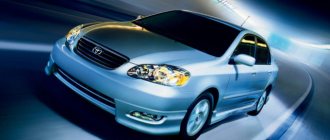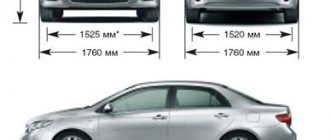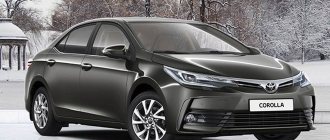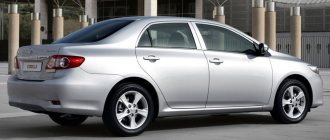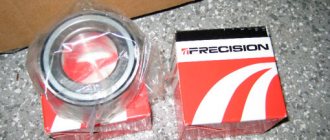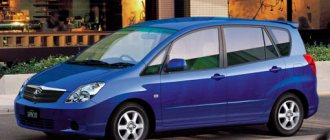Toyota Corolla E100 [restyling] JDM station wagon 1.6 MT 4WD 1997–2000
Car make:
Toyota
Name:
Toyota
Model:
Corolla
Generation:
E100 [restyling] JDM station wagon
Modification:
1.6 MT 4WD
Years of manufacture:
1997–2000
Main characteristics (body)
| Maximum trunk volume (l) | 1835 |
| Minimum trunk volume (l) | 889 |
| Front wheel track (mm) | 1460 |
| Wheelbase (mm) | 2465 |
| Height (mm) | 1475 |
| Width (mm) | 1685 |
| Rear wheel track (mm) | 1450 |
| Ground clearance (mm) | 155 |
| Curb weight (kg) | 1230 |
| Length (mm) | 4315 |
Engine
| Cylinder diameter (mm) | 81 |
| Number of valves per cylinder | 4 |
| Number of cylinders | 4 |
| Piston stroke (mm) | 77 |
| Maximum torque (N•m) | 149 |
| Maximum torque speed, max. (rpm) | 4600 |
| Maximum power speed, max. (rpm) | 5800 |
| Intake type | Distributed injection |
| Engine Configuration | Row |
| Engine power (hp) | 110 |
| Engine capacity (cm3) | 1587 |
| engine's type | Petrol |
Transmission
| Number of steps | 5 |
| Drive unit | Full |
| Transmission | Mechanics |
Suspension and brakes
| Rear brakes | Drums |
| Front brakes | Ventilated disc |
| Rear suspension | Independent, spring, double wishbone, with anti-roll bar |
| Front suspension | Independent, spring, McPherson |
Performance characteristics
| Fuel tank volume (l) | 50 |
| Recommended fuel | AI-92 |
Steering
| Turning diameter (m) | 9.6 |
| Power steering | Power steering |
Tires, wheels
| Discs | Front | Rear |
| Rim width | 5,5 | 5,5 |
| Rim diameter | 14 | 14 |
| Hole Pattern Diameter (PCD) | 100 | 100 |
| Number of mounting holes | 4 | 4 |
| Tires | Front | Rear |
| Tire diameter | 14 | 14 |
| Tire profile height | 65 | 65 |
| Tire section width | 185 | 185 |
Related publications
Model history
The first launch-generation car rolled off the assembly line in 1966. This model was innovative back then. She made a breakthrough in the automobile industry. In the Corolla model range, only one version with a hatchback body was presented. The second generation of the car has changed little in appearance, but the range of engines has been updated. The car was produced in two versions - coupe and hatchback. A story about each generation can take a lot of time and text, so let’s move straight to the year when the station wagon appeared. This is exactly what this article will be about.
Toyota Corolla Wagon: technical specifications
Date: 02/18/2015
The Toyota Corolla, now in its eleventh generation, pleases its fans with consistent quality and safety. Throughout its existence, Toyota Corolla has developed not only its technical characteristics, but also “changed its skin” many times, appearing in a new combination of bodies with each generation.
Evolution of the Toyota Corolla Wagon
In 1997, with the release of the eighth generation of the model, a 5-door station wagon was released, which received its own name - Toyota Corolla Wagon. The Toyota Wagon was equipped with the same engines as the sedan version, but was not supplied to the USA. The car enthusiast had a choice of petrol (1.3l and 1.6l) and diesel (2.0l) versions. The car was equipped with several types of transmissions: 3- or 4-speed automatic and 5- or 6-speed manual.
The first version of the Toyota Corolla Wagon station wagon
Three years later, in 2000, the company introduced a new version of the 5-door Corolla Wagon station wagon, which became known as the Corolla Fielder in the Japanese market. The 1.6L petrol engine or 1.9L and 2.0L diesel engines have become more economical and environmentally friendly.
The 2000 Wagon was replaced by a new generation of Toyota Corolla, which also made it possible to choose a station wagon body. Despite the desire of the developers to make the car more comfortable and improve the quality of performance, some necessary functions have still been offered as options. This applies to air conditioning, electric windows, and central locking with remote control. ABS, for example, was installed by default on the Toyota Corolla Wagon only in the top version. The Toyota Corolla still remained predominantly front-wheel drive, but allowed 4-wheel drive to be installed for an additional fee. At this time, 1.4l and 1.6l petrol engines and 2.0l diesel engines were installed on Wagon station wagons.
Technical characteristics of the Corolla Wagon
In 2004, the previous Toyota Corolla Wagon was replaced by updated cars, the main changes in which relate mainly to the presence of standard functions (ABS, air conditioning, electric windows). The 2004 versions are available with a petrol (1.4L and 1.6L) or diesel engine (1.4L and 2.0L). Corolla Wagon is a station wagon with a relatively large load capacity, the technical characteristics of which are impressive. The maximum speed of a representative of this generation (with a 1.6 liter engine) according to the manufacturer is 190 km/h, consumption is up to 9.2 liters of gasoline/100 km in the city (7.2 liters in the combined cycle) or 7.3 liters of diesel per 100 km in the city (5.7 l in the combined cycle; 2.0 l engine).
Updated Toyota Wagon
Toyota Corolla with a 1.4 liter engine has a power of 97 hp, torque – 130 Nm; 4400 rpm, accelerates to 100 km in 12 seconds and reaches a maximum speed of 185 km/h. More powerful 1.6 liter engine (110 hp), acceleration time to 100 km/h – 10.2 seconds, torque – 150 Nm; 4800 rpm
The car is quite roomy, the trunk volume of the car is 402 liters, with the seats folded down - 872 liters.
Corolla Wagon: comfort and safety above all!
Vehicle safety is ensured by the presence of:
- ABS anti-lock brake system in the latest generation Toyota Corolla Wagon;
- EBD brake force distribution systems;
- airbags for the driver and front passenger;
- side airbags
Depending on the configuration, the car may have anti-slip and stability control systems, and side curtain airbags. In addition, the Toyota Corolla Wagon is equipped with child seat anchors, child lock protection, and rear seat belts.
Roomy Toyota Corolla Wagon
Additional options that affect the comfort of the driver and passengers include central locking, power windows, power steering, cruise control, air conditioning and climate control, an audio system, the presence of sports seats and a leather steering wheel, and their adjustment.
The main advantages of the Toyota Corolla Wagon are the vaunted “Toyota” safety and reliability on the road, trunk capacity and space inside thanks to the wide wheelbase, the use of high-quality materials and parts in the car’s exterior and interior, and good technical characteristics.
Thus, the Corolla Wagon is a successful variation of the usual Toyota Corolla on the theme of a universal and roomy car. The full-size station wagon is perfect for the role of both a family car and a powerful “workhorse” for transporting large items and cargo.
Other articles
Salon
The interior space of models produced between 1998 and 2000 remains large, allowing comfortable seating for five passengers. Thanks to the large windows, visibility in the car is quite large; the only thing in the front part is the front windshield pillars that slightly limit the view.
As for the luggage compartment, its volume is 402 liters, and with the rear row of seats folded it increases to 1500 liters.
Starting from the 8th generation, all station wagons are equipped with comfortable adjustable seats with excellent finishing, climate control, as well as high-quality plastic.
Latest Versions
The ninth generation Toyota Corolla (station wagon) was introduced at the end of 2000. The body bore the index E120. The design of the car has changed dramatically. The car body was completely redesigned. Two years later a small facelift followed. The interior decoration remains unchanged. The ninth version is the most popular in the entire model range, both in sedan and station wagon form. The Corolla has more than once become the car of the year according to numerous publishers and critics due to its dizzying sales volumes and extremely positive reviews from its owners.
In 2006, the Japanese presented the tenth body of the model. The changes affected the appearance and range of engines. It is worth noting that the car was the first in the world to receive a 5-star safety rating in its segment. In 2012, the eleventh and current generation of the Toyota Corolla was introduced. The station wagon body received a hybrid version with an electric motor in addition to the standard line of units. In 2015, there was a slight restyling of the appearance. This is the car we will be talking about.
Exterior and interior
The car looks in keeping with the rest of the company's lineup. Large radiator grille, front optics are connected to it. On top there is a chrome strip that emphasizes the line of the hood. In general, the new version of the station wagon is more similar to the Subaru Impreza than to the familiar and family-friendly Corolla. From the side it immediately becomes noticeable that the car is perfectly balanced in terms of body dimensions. The rear of the car fits perfectly with the face and is made in the same style. The appearance of the car can be called anything you like - sporty, daring, aggressive, but not calm and family-friendly. There is no trace left of the roots of the ninth and tenth generations in this car. There is even a noticeable slight bias towards Lexus in terms of design. Let's move on to the car interior.
The inside of the Toyota Corolla (station wagon) is very cozy and spacious. In its maximum configuration, the car is equipped with a wide variety of tracking systems, multimedia and much more. The interior is very roomy, travel will be comfortable even for a large family or group of friends. Of course, the class level is felt - in terms of build quality and equipment, the model does not reach its older brother. The Toyota Corolla (station wagon), left-hand drive, which is produced only for the European market, is called Sprinter Wagon in its homeland. There is practically nothing to complain about in terms of seat comfort. Unless in cheaper trim levels you will not get automatic height and tilt adjustment. But let's not forget about the class of the car and the segment of buyers for whom it is intended.
The emergence of a station wagon
In the fifth generation, the Toyota Corolla (station wagon) appeared, which immediately won the hearts of fans of the model. A new diesel unit with a volume of 1.8 liters has also become available. Two years after its release, the car began to be exported from Japan to the USA and sold in the country’s domestic market. Almost all models were produced with front-wheel drive, except for versions AE 86 and AE 85. They were equipped with permanent all-wheel drive. The station wagon body received the prefix Wagon and began to be actively distributed by official dealers.
In the sixth generation of the model, introduced in 1987, the creators decided to radically update the outdated body design. Thus, the car turned out to be more rounded and in line with the fashion of the time. The car was still equipped with front-wheel drive and all-wheel drive. Under the hood they installed a wide variety of engines that the previous Toyota Corolla had. The price for such a car has increased significantly since the model moved up one class.
The seventh generation of the station wagon brought with it even more changes. First of all, they concern the body. The shapes became softer, and the company's corporate style gradually emerged. The car has become significantly heavier due to the increased wheelbase. Almost all copies were produced with injection units under the hood - Toyota completely abandoned carburetors.
The eighth generation appeared at the end of 1995. Common features in the body were visible with the previous version. But the creators made the car smoother. The model received a new 1ZZ-FE engine. Due to the lightweight engine, the station wagon has become much lighter than its predecessor.

